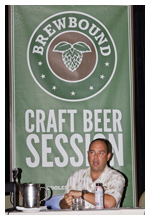
Speakers included Kona Brewing Co. President Mattson Davis, Port/The Lost Abbey Co-Founder Tomme Arthur, Director of Sales and Marketing for The Bruery Benjamin Weiss. Notable attendees included Coronado Brewing President Rick Chapman and Bear Republic CEO Richard Norgrove.
During the morning session of BevNET live, the biggest theme to emerge was the importance of building authentic brands. This theme again appeared throughout the craft beer session.
Kicking off the event was Mattson Davis with a keynote address, in which he advocated for building a brand based on honesty and integrity and finding the right brand partner. Davis believes that in order to build a successful craft brand, you must transcend into other markets with the company message.
In looking at the industry as a whole, Davis said he believes over the next five years the U.S. craft market will swell to between 3,000 and 4,000 craft brewers. He believes most of these brewers will be niche, local brands that produce between 1,000 and 3,000 barrels annually.
Davis also speculated that 15 to 20 breweries will cover the national landscape, 12 of which will own over 80 percent of the craft beer market share. And citing Mike Mazzoni, he noted that craft beer is five years into its 20-year brand life cycle.
Following Davis was First Beverage Founder and CEO William Anderson. Anderson discussed the key headwinds facing craft brewers as many startups look to secure financing and already established brands look to expand.
Anderson gave the audience a look at what the craft industry ‘was,’ and it ‘is now.’ He highlighted many key differences in consumer values that have helped to cultivate a renewed interest in craft beer. Chief among them was the shift from a brand image to a brand story and the attention to community and responsibility.
But Anderson also listed seven key headwinds the craft industry faces:
- Rampant consumer promiscuity
- High expansion capacity costs
- Private label crafts on the rise
- Duopoly pressures to sell crafts
- Distributor limitations
- Management skillset gaps
- Generational transfers

John Bryant, a former executive with Deschutes, Odell and Oskar Blues then gave a brief presentation on how craft brewers can improve their chances of making it on a retailer’s shelf. In his discussion, he stressed the importance of storytelling and supporting that story with ‘hard-assets.’ He also discussed the ‘basket-ring,’ a concept popularized by industry expert Bump Williams. Bryant described how the craft consumers ‘basket’ is more valuable than the average consumer – improving the retailers margins.
Following Bryant was CM Profit Group Founder Thomas Fox who provided a nice acronym for craft brewers to reference when building their retail proposals. Sales, Profit, Rings, Image, Traffic and Excitement (SPRITE) are all important things to consider if small brewers are looking for success at retail. Also joining the panel discussion was Jason Mussetter of Mussetter Distributing. He stressed how important it is for craft brewers to sample beer at festivals and also discussed why distributors appreciate consistent visits from their brewery partners.
The day ended with a spirited discussion on label designs and brand positioning. Tomme Arthur (Port/The Losy Abbey), Benjamin Weiss (The Bruery), Ian McLean (McLean Design) and Mark Mitchell (Interrupt Marketing) gave their thoughts on how a craft brewer’s label design can improve their marketability on the shelf. The group debated the longevity of cans as a package; something McLean still thought looked “cheap.” The group agreed that establishing a strong brand position and marketing approach before designing label artwork was a critical to the success of a craft brand.
